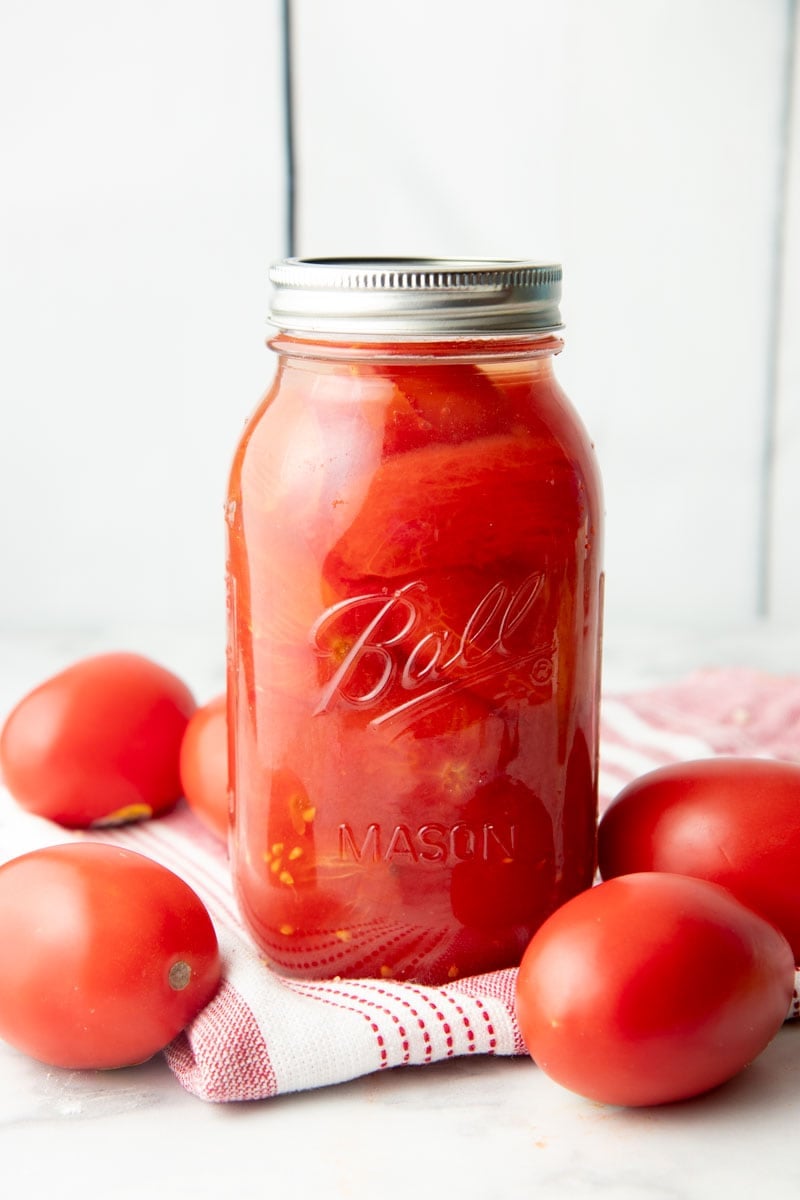Whether you’re brand new to canning or a canning professional, canning whole tomatoes is a great way to use an abundant tomato harvest or a windfall of tomatoes from the farmers’ market.
Canning whole tomatoes require very little prep work, and they’re one of the fastest ways to preserve your tomatoes at their peak ripeness. Whole tomatoes are also versatile. You can use them whole in soups, crush them to create tomato sauces, or dice them to toss into your favorite dishes in the cold winter months. No matter how you use them, you can be guaranteed they’ll be bursting with delicious, juicy flavor that will transport you back to the dog days of summer.
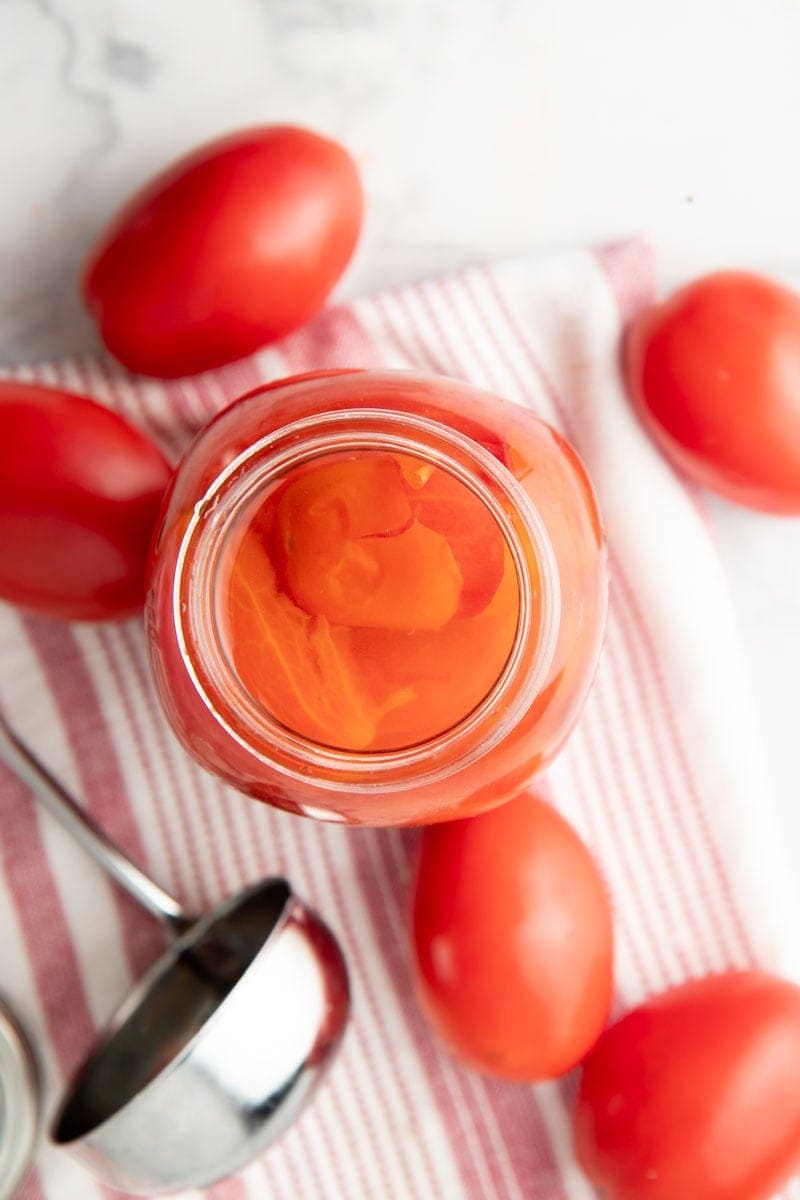
What do I need to begin canning whole tomatoes?
Thankfully, canning whole tomatoes requires very little equipment. The majority of supplies you need you can find in your kitchen. These include ladles, knives, cutting boards, and funnels. However, there are a few supplies that you should pick up.
- Jars with lids and rings: If you don’t already have clean canning jars, now’s the time to get them! Make sure that you purchase new lids and rings even if you’re using sterilized jars, since canning jar lids can’t be reused. These should be easy to find in most hardware and grocery stores, especially in the fall.
- A water bath canner: A water bath canner is essentially a large stockpot with a canning rack. If you already have a large stockpot, you can use this, but you’ll have to purchase the rack the jars will sit on. Otherwise, you can buy water bath canners at hardware stores, large grocery stores, or online. If you choose to use a large pot instead of a water bath canner, make sure it’s big enough that your jars can be completely submerged under the water. This allows for even processing.
- Jar tongs or lifter: Glass jars are slippery when they’re wet, and they’re impossible to lift out of boiling water without a pair of handy jar lifters. Jar tongs are specially designed to fit around the rim of your jar, allowing you to safely lift your hard-earned canned goods out of your canner. They’re inexpensive, and I wouldn’t recommend canning without them! You can often buy canning kits that include some must-have tools such as the rack, jar tongs, and a funnel.
That’s pretty much all you’ll need to get started! If you’re looking for a more detailed overview of water bath canning, you should head on over to our intro to canning.

How do I can tomatoes whole?
The process for canning whole tomatoes is super simple:
- Prepare your jars by cleaning them well with warm soapy water. Your jars can be left in simmering warm water until you’re ready to use them. Fill your water bath canner with water and start bringing it to a boil on the stove.
- Meanwhile, prepare your tomatoes by blanching them in boiling water for 30 seconds and then transferring them to ice water. This should allow the skins to easily slip off. If you’re leaving the skins on, you can skip this step and head straight to removing the cores and stems of your tomatoes.
- You don’t strictly have to remove the cores, but it makes them a little more enjoyable to cook with later. Just use a sharp paring knife to cut the cores out.
- Add your acid to your jars. You can use bottled lemon juice, citric acid, or 5% vinegar. Pint jars should have ¼ teaspoon of citric acid, 1 tablespoon of lemon juice, or 2 tablespoons of 5% vinegar added, while quart jars require ½ teaspoons citric acid, 2 tablespoons of bottled lemon juice, or 4 tablespoons of vinegar.
- Pack tomatoes tightly in the jars. You can squish them down slightly to allow the juice to surround the tomatoes. Make sure you remove any air bubbles and leave ½-inch headspace.
- Process jars for an hour and 25 minutes. This time can change depending on your altitude, so make sure you research canning times for your location before canning.
- After the processing time is up, allow your tomatoes to sit for five minutes before removing them from the canner. They should then sit for 24 hours, until the jars have completely sealed and cooled down. Test the seals by pressing on the middle of the lid—if the flat lid doesn’t pop up and down, then the jars sealed properly and can be safely stored at room temperature.

Do these tomatoes need to be pressure canned?
Nope! The beauty of tomatoes is that they’re acidic enough to be canned in a water bath canner as long as you add citric acid or lemon juice. This means that you don’t need to invest in a pressure canner to enjoy your tomato harvest year-round!
Do you have to put lemon juice or citric acid in canned whole tomatoes?
Yes! Tomatoes need added acidity from lemon juice or citric acid to be safely processed in a water bath canner. They’re not quite acidic enough on their own to be shelf stable.
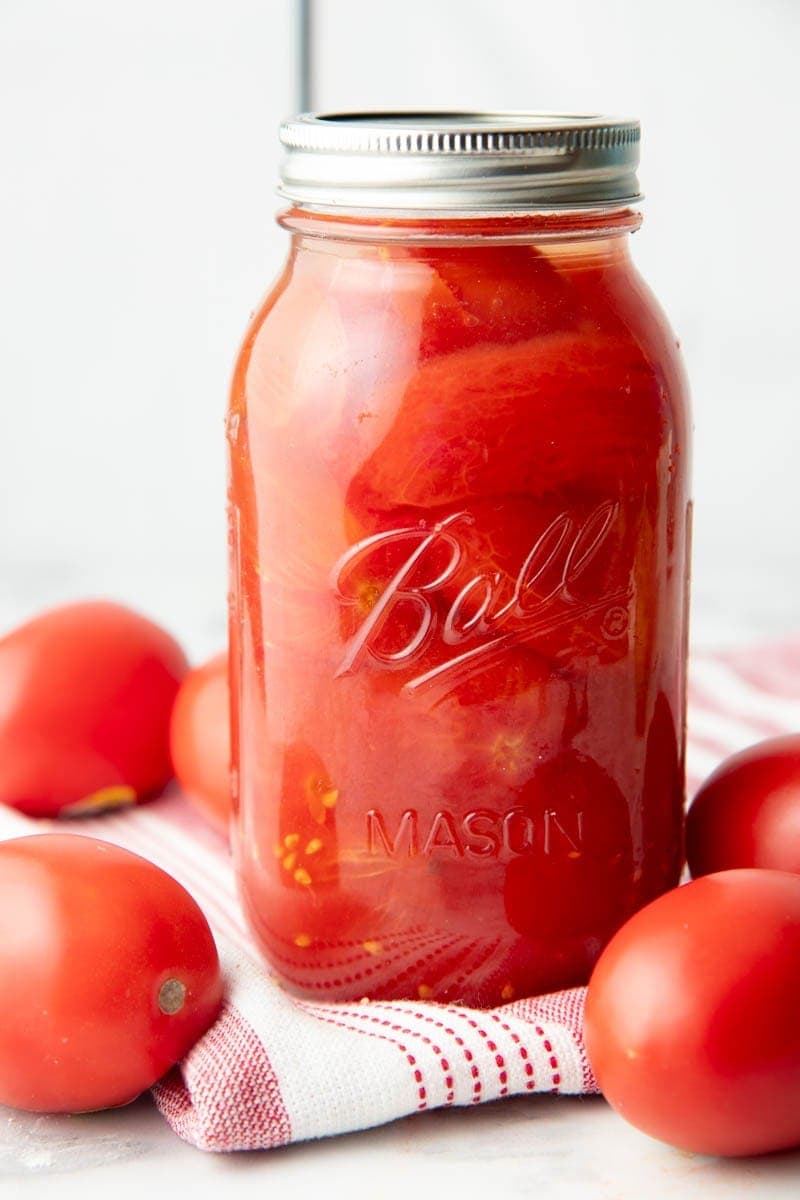
What are the best tomatoes to use?
The short answer is that any tomatoes you have on hand are the best ones to use. You can use plum, slicing, cherry, or grape tomatoes. Whatever tomato your garden grew in abundance can be packed in a jar and preserved whole using this recipe for canning whole tomatoes.
However, you’re going to get best results by using plum tomatoes (AKA: roma tomatoes or San Marzano tomatoes). That’s what we prefer to can with!
Do you add water when canning whole tomatoes?
You don’t need to add water to your jars when canning whole tomatoes. Instead of water, whole tomatoes will sit in their own juices. This keeps the flavor fresh and doesn’t water down your canned tomatoes when you go to use them.
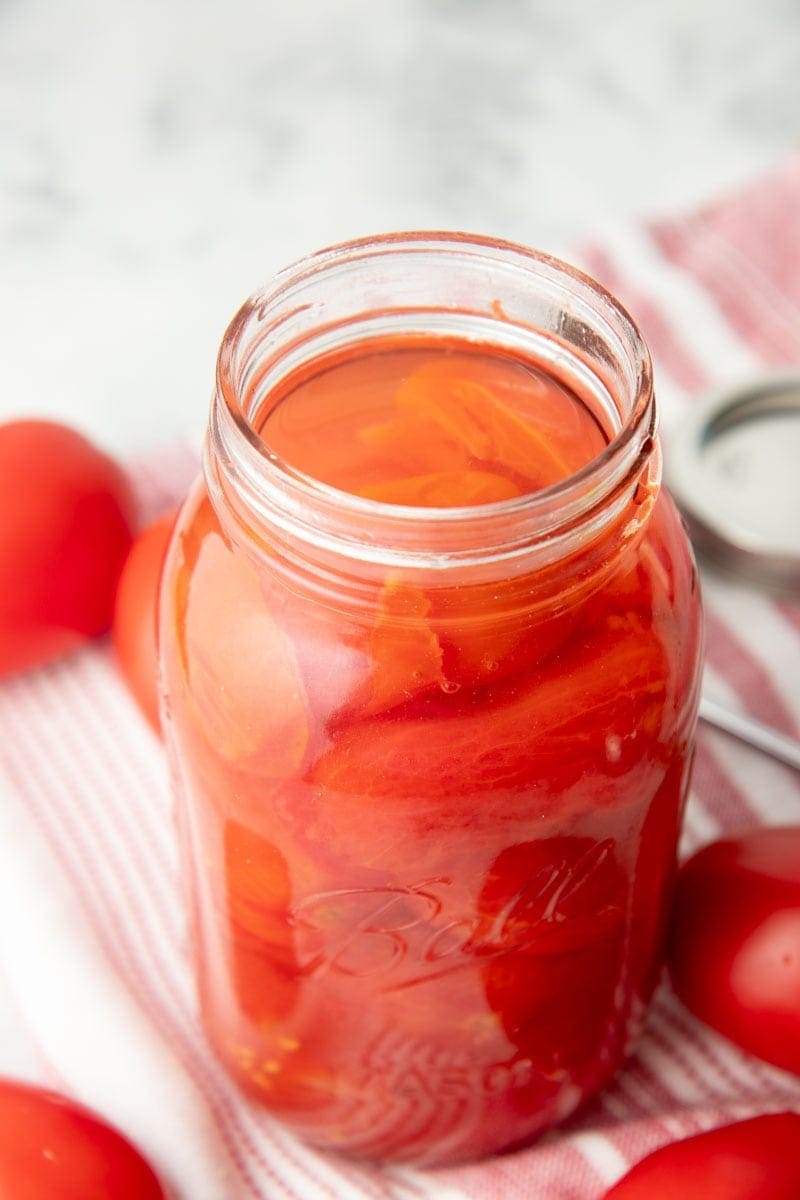
Do I have to peel the tomatoes first?
Peeling your tomatoes first isn’t something you have to do, but it’s something that we recommend. Tomato peels can get tough and unappetizing during the canning process, so we prefer to peel tomatoes before canning them. Our post on canning diced tomatoes has a bunch of great information on getting your tomatoes ready for canning. You can read all about peeling your tomatoes there.
The advantage of peeling your tomatoes first is that any potential bitterness and toughness from the tomato skins is removed. Of course, if you’re not concerned about this, it saves you some time if you just plop your whole tomatoes (minus the stem and core) into your jars for processing.
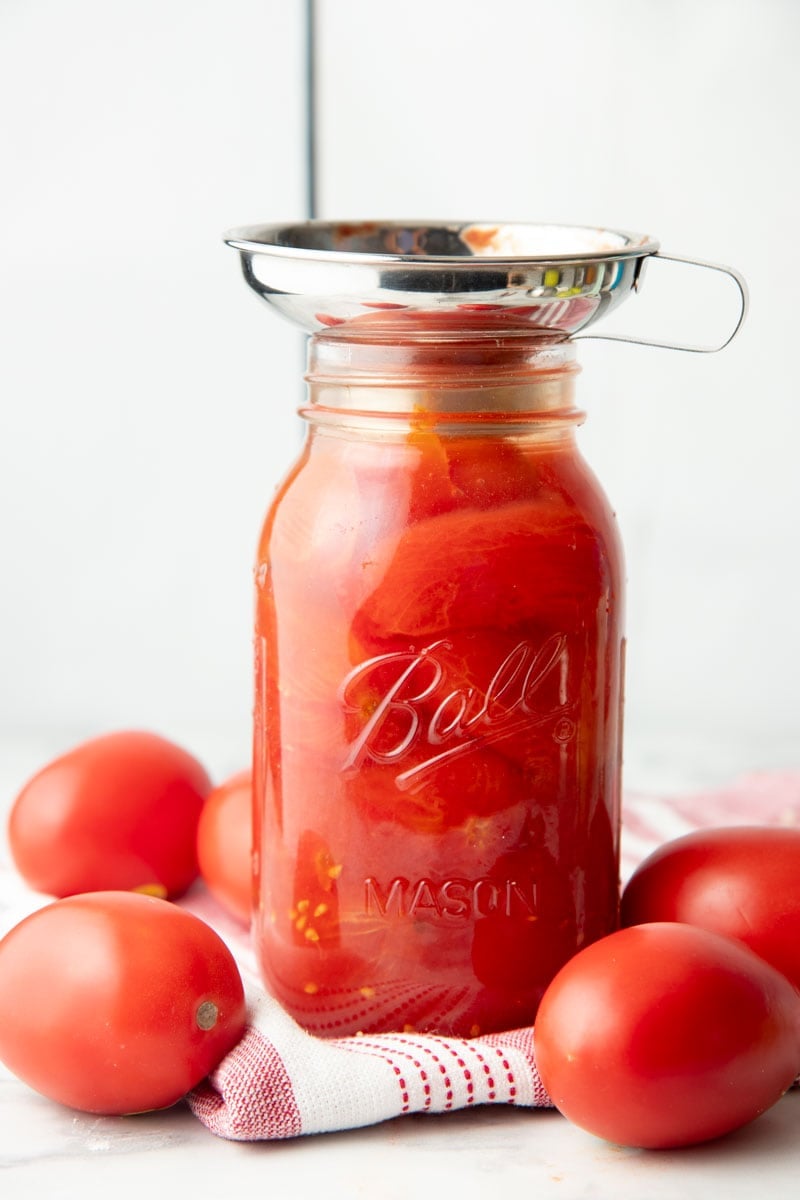
Can you freeze the tomatoes instead?
Absolutely! Freezing your tomatoes is quick, and it’s an easy way to preserve your harvest. If you’d like to know more, you can find detailed steps in our post on how to freeze tomatoes.
How long will canned whole tomatoes keep?
As long as they’re stored in a cool, dry, dark place, your canned whole tomatoes should keep their flavor and quality for roughly 18 months. If they’re stored properly, you can safely eat them beyond that point; however, you might find that their flavor or texture has gone a little off.
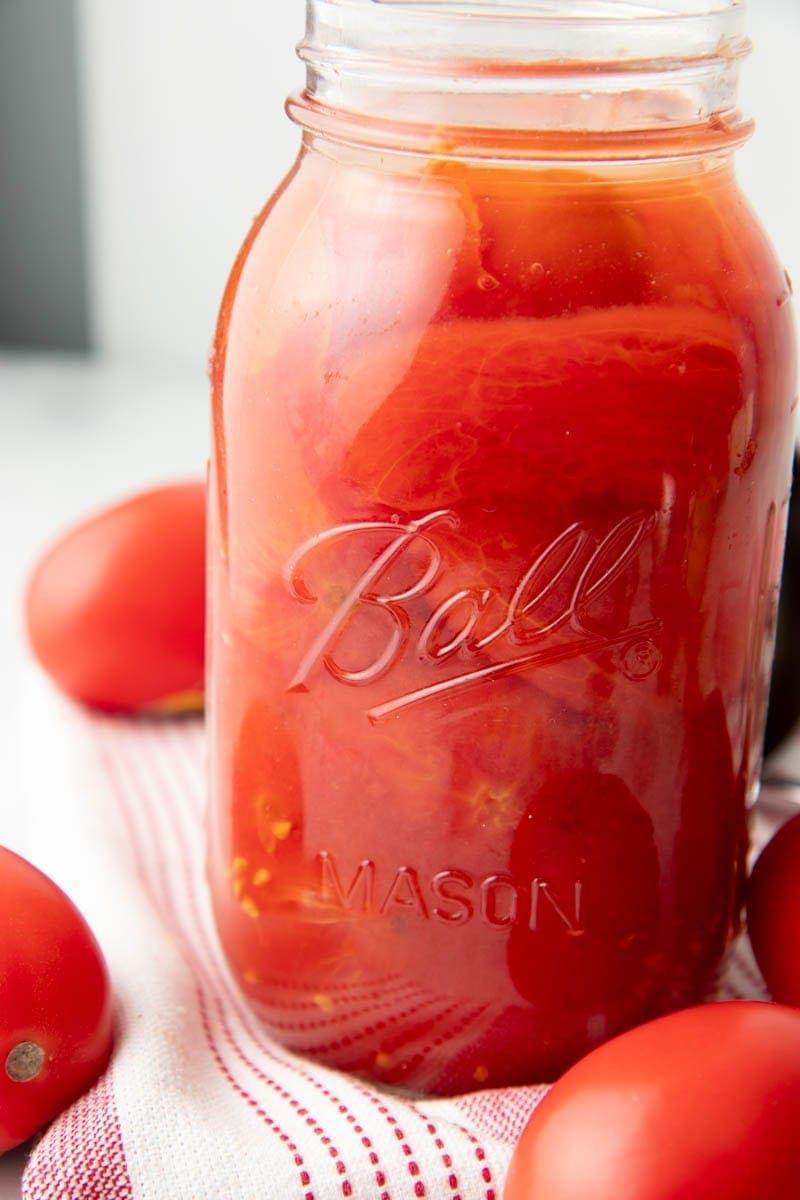
How long will the tomatoes be good once they’re opened?
After opening a jar, you should aim to eat your tomatoes within a week. They’re still safe to eat for up to 10 days, but if you don’t think you’ll get through them in that time frame, it’s best to freeze any of your leftover tomatoes while they’re still in that one-week window for maximum freshness.
Is it okay that the tomatoes and liquid separated?
If you see your tomatoes and liquid have separated, don’t fret—they’re still perfectly safe to eat. The flesh of tomatoes are packed with small pockets of air, and those air pockets make the tomatoes float during the canning and cooling process. After a few days on the shelf, the tomatoes will probably resettle. Either way, the tomatoes are perfectly safe to eat.
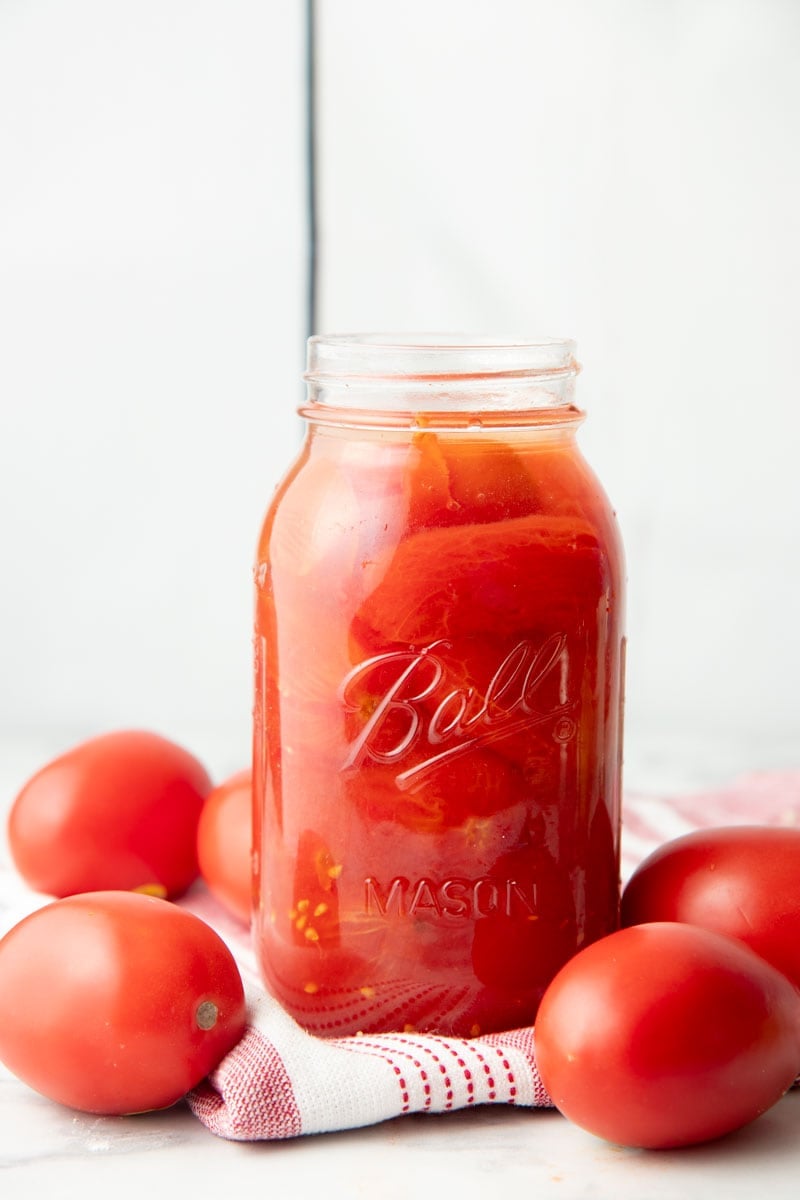
How can I use canned whole tomatoes?
Canned whole tomatoes can be used almost anywhere you use other kinds of canned tomatoes. Drain the whole tomatoes and dice to use in place of diced tomatoes. Use your hands to smoosh the whole tomatoes to make crushed tomatoes (this is really satisfying). Blend in a blender to make tomato puree or tomato sauce.
We’ve used our canned whole tomatoes in chili, spaghetti sauce, stews, soups, and almost any dish that used tomatoes!
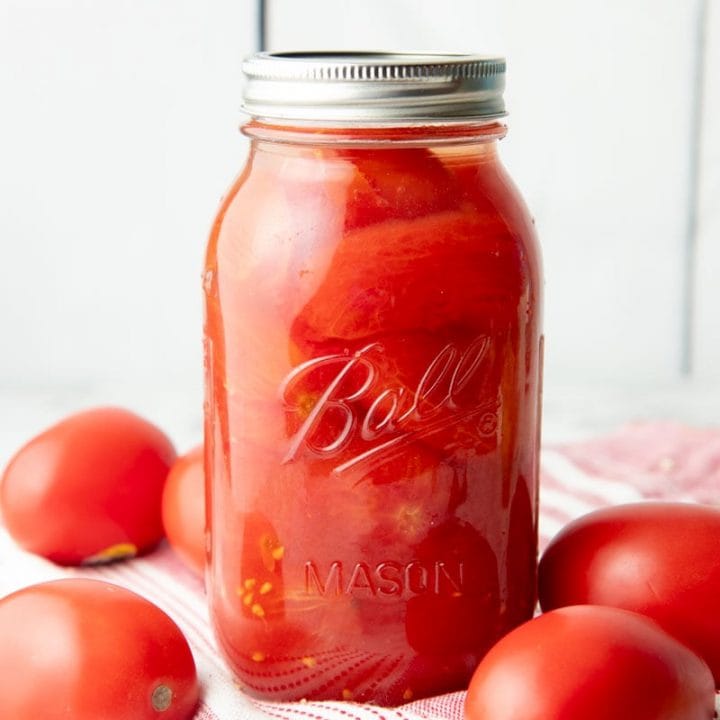
Canning Whole Tomatoes
It’s tomato season! With this step-by-step guide, you’ll be canning whole tomatoes in no time. They make a fuss-free addition to your pantry.
Ingredients
- 7 1/2 to 10 1/2 pounds tomatoes (23-32 medium tomatoes)
- Citric acid or bottled lemon juice
- Salt (optional)
Instructions
- Prepare boiling water canner. Heat jars in simmering water until ready to use, but do not boil. Wash lids in warm soapy water and set aside with bands.
- Wash tomatoes under cold running water. Peel by blanching for 30-60 seconds in boiling water, and immediately transferring to a large bowl of ice water. Slip off the peels and core the tomatoes.
- Add ¼ teaspoon citric acid or 1 tablespoon bottled lemon juice to a hot pint jar; ½ teaspoon citric acid or 2 tablespoons bottled lemon juice to a hot quart jar. If using salt, add 1/2 teaspoon salt to pint jars, or 1 teaspoon salt to quart jars.
- Pack raw tomatoes into jar, pressing gently so that tomato juice fills the spaces between tomatoes, leaving 1/2-inch headspace.
- Remove air bubbles and adjust the headspace as needed. Clean jar rim, and then center lid on jar and adjust band to fingertip-tight.
- Place jar on a canning rack in the boiling-water canner. Repeat until all jars are filled.
- Lower the rack into the canner, making sure that the water rises at least one inch above the lids of the jars. Cover and bring to a rolling boil. Process both pint and quart jars for 1 hour and 25 minutes (85 minutes).
- Turn off heat and remove lid. Let jars cool for five minutes, then remove jars to a folded dish towel. Cool 12 hours and test seals. Label and store jars.
Nutrition Information:
Yield: 24 Serving Size: 1/2 cupAmount Per Serving: Calories: 36Total Fat: 0gSaturated Fat: 0gTrans Fat: 0gUnsaturated Fat: 0gCholesterol: 0mgSodium: 34mgCarbohydrates: 8gFiber: 2gSugar: 5gProtein: 2g
At Wholefully, we believe that good nutrition is about much more than just the numbers on the nutrition facts panel. Please use the above information as only a small part of what helps you decide what foods are nourishing for you.

